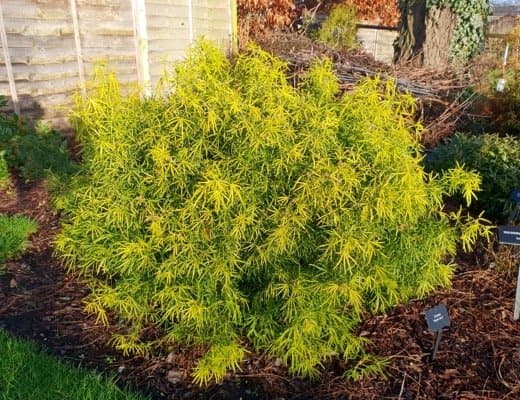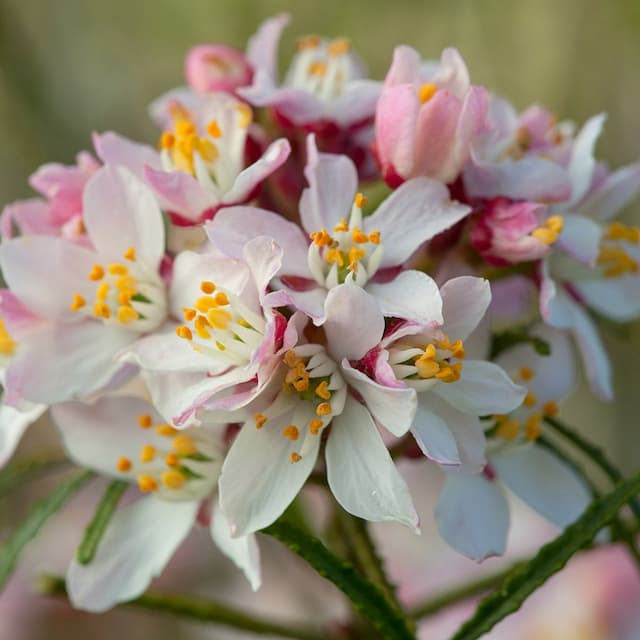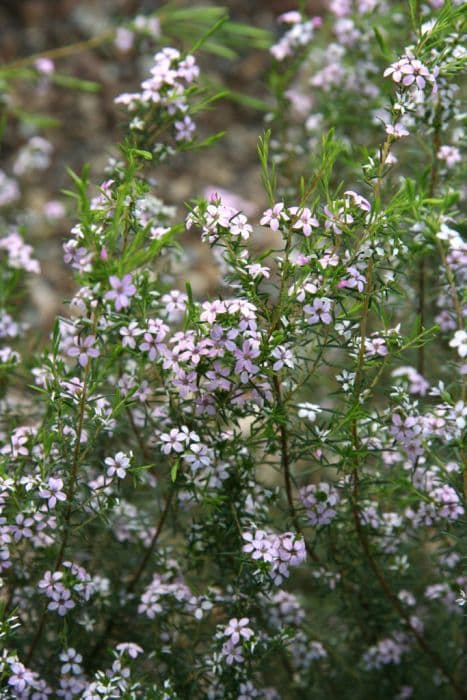Japanese pepper Zanthoxylum piperitum

ABOUT
The plant commonly known as Japanese pepper is a decidituous species characterized by its aromatic and pinnate leaves, which are composed of smaller leaflets arranged along a central stem. The green leaves give off a citrus-like fragrance when crushed. This plant boasts small clusters of greenish-yellow flowers that are not particularly showy. As it matures, the plant produces small fruit or peppercorns, which typically change from green to red or dark brown when ripe. These tiny, round fruits are known for their unique, peppery taste and are often used as a spice in cooking. The bark of the Japenese Pepper sports a rough texture and may have a gray to brown coloration. The plant's overall form can be quite shrubby, and it is adorned with both thorns and sharp spines that provide a certain level of natural defense.
About this plant
 Names
NamesFamily
Rutaceae
Synonyms
Japanese Pepper, Japanese Pricklyash, Korean Pepper, Sanshō, Chopi
Common names
Zanthoxylum acanthopodium, Zanthoxylum argyi, Zanthoxylum podocarpum, Zanthoxylum piperitum var. inerme, Zanthoxylum piperitum var. tomentosum.
 Toxicity
ToxicityTo humans
Japanese pepper, commonly known as Zanthoxylum piperitum, is not generally considered toxic to humans. In fact, parts of the plant, such as the seeds, are used as a spice in cuisine, especially in East Asian dishes. However, as with many plants, some individuals may experience mild allergic reactions or irritation if they have sensitivities. Ingesting large amounts of the plant may cause gastrointestinal discomfort or upset, much like consuming any non-toxic plant material in excess. There are no widely known severe toxic effects of Japanese pepper on humans when consumed in typical culinary amounts.
To pets
Japanese pepper, or Zanthoxylum piperitum, has not been widely reported to be toxic to pets. This plant, while not commonly consumed by animals, might lead to mild gastrointestinal upset if ingested in significant quantities, similar to many other non-toxic plants. There is no well-documented evidence of severe poisoning in pets from consuming parts of the Japanese pepper plant. As with any non-food plant, keeping an eye on your pet's behavior and preventing them from eating large quantities is advisable, as each individual pet may react differently. If you have concerns about possible ingestion, it is always best to consult with a veterinarian.
 Characteristics
CharacteristicsLife cycle
Perennials
Foliage type
Deciduous
Color of leaves
Green
Flower color
Yellow-green
Height
15-20 feet [4.6-6 m]
Spread
10-15 feet [3-4.6 m]
Plant type
Shrub
Hardiness zones
6
Native area
East Asia
Benefits
 General Benefits
General Benefits- Culinary Uses: The fruit of the Japanese pepper is often used as a spice or condiment in Asian cuisine to add a unique flavor to dishes.
- Landscape Ornamentation: With its attractive foliage and structure, the Japanese pepper can serve as an ornamental plant in gardens and parks.
- Natural Insect Repellant: The strong scent of the Japanese pepper is believed to be a deterrent to certain insects, making it useful for natural pest control.
- Traditional Culinary Tool: The dried husks of the Japanese pepper are sometimes used in the traditional preparation of certain Japanese dishes, such as sansho.
- Essential Oils: Essential oils can be derived from the Japanese pepper, which are used for various purposes in perfumery and aromatherapy.
- Cultural Significance: The Japanese pepper holds cultural value in regions where it is native, often tied to local customs and cuisine.
- Wildlife Habitat: Plants like the Japanese pepper can provide food and habitat for local wildlife, including birds and beneficial insects.
 Medical Properties
Medical Properties- Analgesic: Zanthoxylum piperitum is traditionally used to alleviate pain.
- Anti-inflammatory: It may have properties that reduce inflammation.
- Antimicrobial: Has been used to combat microbial infections.
- Antipruritic: Can be used to relieve itching.
- Digestive aid: May help in digestion and gastrointestinal issues.
- Antiparasitic: Used in some cultures to treat parasitic infections.
- Antioxidant: Contains compounds that may act as antioxidants.
- Antispasmodic: Potentially useful in alleviating spasms or cramps.
- Dental care: Sometimes used in dental hygiene products for its antimicrobial properties.
- Circulatory stimulant: May help in improving circulation.
 Air-purifying Qualities
Air-purifying QualitiesThis plant is not specifically known for air purifying qualities.
 Other Uses
Other Uses- Zanthoxylum piperitum, commonly known as Japanese pepper, is used in traditional East Asian dyeing processes to create a natural yellow dye for fabrics.
- The spiny branches of the Japanese pepper can be used for creating natural barriers or living fences to deter animals or intruders.
- The wood of Japanese pepper is sometimes used in the making of small wooden utensils like chopsticks, due to its durability.
- Juvenile branches can be incorporated into bonsai culture, appreciated for their interesting form and leaf shapes.
- Essential oils extracted from Japanese pepper are used in the perfume industry for their unique, peppery aroma.
- In some regions, husks from the fruit are added to soil as a natural insect repellent in agricultural applications.
- Japapanese pepper leaves are sometimes used as a natural potpourri or in sachets for a subtle fragrance in clothing drawers.
- The plant's seeds can be a component in potting mixtures for plants that thrive in well-draining, nutrient-rich soils.
- Japanese pepper twigs and leaves can be used in creating natural wreaths and other decorative floral crafts for their distinctive look.
- Bark from Japanese pepper can be used in small-scale tanning processes, imparting a unique scent to the leather.
Interesting Facts
 Feng Shui
Feng ShuiThe Japanese pepper is not used in Feng Shui practice.
 Zodiac Sign Compitability
Zodiac Sign CompitabilityThe Japanese pepper is not used in astrology practice.
 Plant Symbolism
Plant Symbolism- Protection: Zanthoxylum piperitum, also known as Japanese Pepper, has been used in various cultures as a symbol of protection due to its prickly appearance which is believed to ward off negative energies and harmful spirits.
- Purification: The aromatic qualities of Japanese Pepper are often associated with purification, suggesting its ability to cleanse a space or individual of impurities and negativity.
- Healing: As a plant with medicinal properties, Japanese Pepper symbolizes healing and is thought to aid in the recovery from illness or to soothe physical discomfort.
- Strength: The hardy nature and resilience of the Japanese Pepper plant are emblematic of strength and the ability to overcome challenges or adversity.
- Good Fortune: In some cultural traditions, Japanese Pepper is believed to attract wealth and prosperity, and it is sometimes used in rituals or decorations to bring good fortune.
 Water
WaterThe Japanese Pepper, commonly known as Szechuan Pepper, should be watered when the top inch of soil feels dry to the touch. This typically means watering once a week, but it can vary depending on climate and indoor conditions. Pour water evenly around the base of the plant until it begins to drain from the bottom of the pot, using about half a gallon for a medium-sized plant. During the winter months, reduce watering to every other week or when the soil is noticeably dry, as the plant will enter a dormant period and require less moisture.
 Light
LightSzechuan Pepper plants thrive in bright, indirect sunlight. The ideal spot for this plant is near an east-facing or south-facing window where it's protected from direct afternoon sunlight, which can scorch the leaves. If you're growing the plant indoors, ensure it receives at least 4 to 6 hours of filtered light per day.
 Temperature
TemperatureSzechuan Pepper plants prefer a temperature range of 60°F to 75°F. They can survive minimum temperatures down to 50°F but should not be exposed to cold drafts or temperatures below this range. The optimal temperature for promoting growth is between 65°F and 70°F. If grown outdoors, ensure the plant is protected from frost, which it cannot tolerate.
 Pruning
PruningPruning Szechuan Pepper plants encourages healthy growth and maintains their shape. Prune in early spring before new growth begins to remove any dead or crossing branches and to shape the plant. Light pruning can be done throughout the year to remove spent leaves or control the size, but avoid heavy pruning once new growth has started as it can stress the plant.
 Cleaning
CleaningAs needed
 Soil
SoilJapanese Pepper (Sichuan Pepper) thrives in a well-drained soil mix with good organic content. A mix of loam, sand, and peat with pH between 5.5 and 7.0 is ideal. To provide additional drainage, consider adding perlite or pumice.
 Repotting
RepottingJapanese Pepper should be repotted every two to three years in the spring. Younger, more vigorous plants may require more frequent repotting, annually or biennially.
 Humidity & Misting
Humidity & MistingJapanese Pepper prefers moderate to high humidity levels, ideally between 50% and 70%. It may tolerate lower humidity but may not thrive as well.
 Suitable locations
Suitable locationsIndoor
Place Japanese Pepper in bright, indirect light with good air circulation.
Outdoor
Plant in a sunny spot with shelter from strong winds.
Hardiness zone
6-9 USDA
 Life cycle
Life cycleZanthoxylum piperitum, commonly known as Japanese pepper or Sansho pepper, begins its life as a seed, often dispersed by birds or other animals. Upon germination, which requires stratification to break dormancy, the seedling emerges and develops into a juvenile plant, establishing a root system and producing foliage. As it matures, the plant exhibits rapid vegetative growth, developing compound leaves that are known for their distinctive prickly texture. When it reaches sexual maturity after several years, the Japanese pepper produces small, yellowish-green flowers; being dioecious, individual trees are either male or female. Pollination occurs generally through wind or insects, leading to the development of small, berry-like fruits that turn red when ripe, each containing one seed. The plant completes its life cycle when these seeds are then spread to new locations, giving rise to the next generation of Japanese pepper plants.
 Propogation
PropogationPropogation time
Spring
Propogation: The Japanese pepper, Zanthoxylum piperitum, is most commonly propagated by seed. For optimal growth, seeds should be sown in the fall after collection to allow for natural stratification during the colder months. The process involves cleaning the seeds from the berries and then sowing them directly into a well-draining soil mix. The soil should be kept moist but not waterlogged, and the seeds typically germinate in the spring as temperatures begin to rise. This method takes advantage of the seed's natural cycle and requires minimal intervention, making it the most popular and effective approach for propagation of the Japanese pepper.









